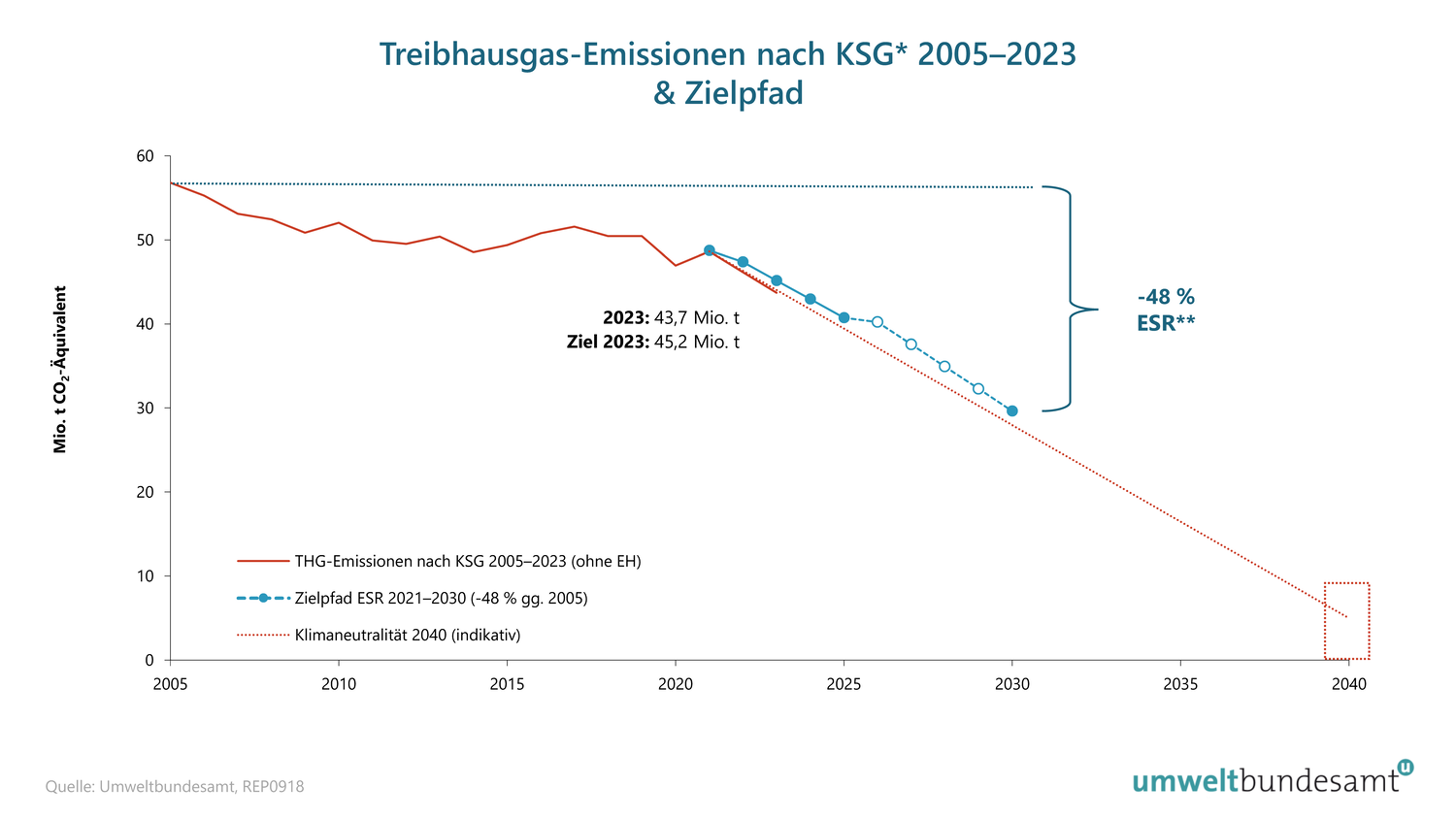Nowcast 2024: Significant reduction in GHG emissions

Yesterday, Environment Minister Leonore Gewessler and Federal Environment Agency expert Günther Lichtblau presented the Federal Environment Agency's latest calculations for the so-called "nowcast", i.e. the estimate of greenhouse gas emissions for the year 2023. At minus 6.4%, the decline in emissions of climate-damaging greenhouse gases (GHG) is significantly higher than predicted. The fact that the majority of the decrease is due to climate protection measures and the ongoing expansion of renewable energy is particularly positive.
The decline in GHG was greater than last forecast. While the forecast in March 2024 was still minus 5.3 %, the current near-term forecast is now clear:
- The decrease in climate-damaging greenhouse gas emissions will be even higher in 2023 at minus 6.4 %.
- This corresponds to a reduction of 4.7 million tonsof CO2 equivalents.
- According to the preliminary data, the figure for 2023 will be 68.2 million tons, i.e. well below 70 million tons.
- Greenhouse gas emissions have therefore fallen by a total of 11.9% in the last two years.
Particularly pleasing:
- The decline is only due to a small extent (around 1 percentage point) to economic influences and the milder weather in 2023.
- The majority of the decline (approx. 5.4 percentage points) is due to climate protection measures such as the ongoing expansion of renewable energy.
This is shown both by calculations from the Federal Environment Agency and a corresponding analysis by the Wegener Center. According to Günther Lichtblau, climate expert at the Federal Environment Agency, an annual GHG reduction of around four to five percent is now required to remain on the target path towards climate neutrality.
Oil and gas price increases accelerate energy transition
According to a press release from the Federal Environment Agency, the available data and analyses show that the price trend for fossil fuels is accelerating the expansion of renewable energy sources and improvements in energy efficiency in many sectors. Together with the climate protection measures adopted by the government, this has led to a significant decline in emissions. The decline in economic output, particularly as a result of lower industrial production and transport activity and the milder weather (3.1 % decrease in heating degree days) compared to 2022, further intensified the decline in emissions in 2023.
Outlook for emissions trading 2023
In the emissions trading sector, there was a decrease of 2.2 million tons ofCO2 equivalent(-8.3%) compared to 2022.
- The largest share of the reduction was due to the decrease in natural gas consumption in energy generation by approx. 27%, which means 1.2 million tons less emissions.
- In addition, the decline in production in the iron and steel industry of around 5% led to a reduction in emissions of around 0.3 million tonsof CO2 equivalent.
Outlook for sectors according to the Climate Protection Act
According to preliminary data, GHG emissions from the sectors covered by the Climate Protection Act will decrease by around 2.5 million tonsof CO2 equivalent(-5.3%). According to current calculations, this includes
- 0.8 million tons to the transport sector and
- 1.5 million tons in the buildings sector - reflecting the impact of the switch to renewable heating systems
"At around 6.4 percent, the reduction in 2023 is more significant than in March. As pleasing as the trend is, it remains necessary to take many more measures in order to achieve the climate targets and climate neutrality."
Courageous climate policy works
"Austria is on the way to climate neutrality by 2040. The Federal Environment Agency's calculations prove this: Courageous climate policy is working. The expansion of renewable energy is running at full speed, record levels of green electricity, the refurbishment campaign, the climate ticket and much more are ensuring that our emissions continue to fall. And by a record-breaking 6.4 percent compared to the previous year. This is excellent news: if we continue like this, we can win the fight against the climate crisis. And that is precisely our mission."
Climate Protection Minister Leonore Gewessler
Positive response from NGOs
Environmental protection organization Greenpeace was pleased that climate-damaging emissions have continued to fall and that Austria is thus meeting its EU obligations for 2023, as the specified maximum limit for greenhouse gases outside of emissions trading has been met (with only 43.7 million instead of the permitted 45.2 million tonnes of CO2 equivalents). At the same time, Greenpeace warns that despite the positive development, it is uncertain whether the 2030 climate targets can be met. Everything depends on the next government, which must consistently drive forward climate protection and implement additional climate protection measures.
Climate protection is not a sprint, but a marathon.
Jasmin Duregger, climate and energy expert at Greenpeace
Global 2000 also reacted positively to the calculations for the climate protection report and explained that this proves that "climate protection is effective" and that "much more ambitious measures" are needed to achieve the long-term goals.
About the near-time forecast (nowcast)
The near-term forecast provides provisional data and trends for greenhouse gas emissions for the year 2023. The calculations for this were carried out using a simplified methodology.
The Federal Environment Agency's near-term forecast is based in particular on
- the current Austrian Air Pollution Inventory (OLI),
- the preliminary energy balance,
- the current data of the emissions trading facilities and
- Current surveys and statistics for the agriculture, waste management and F-gases sectors.
- A detailed near-term forecast is also available for the transport sector.
Link
The latest Nowcast Climate Protection Report 2024 from the Federal Environment Agency







